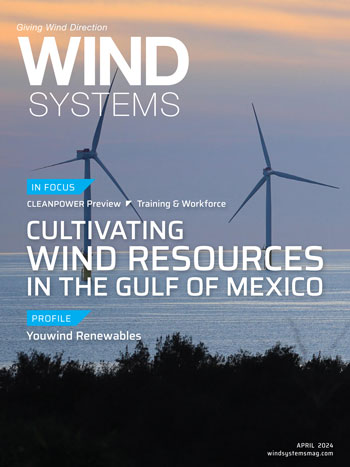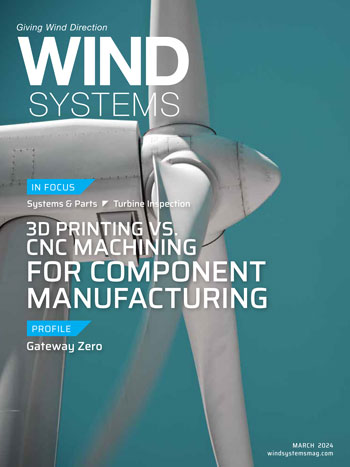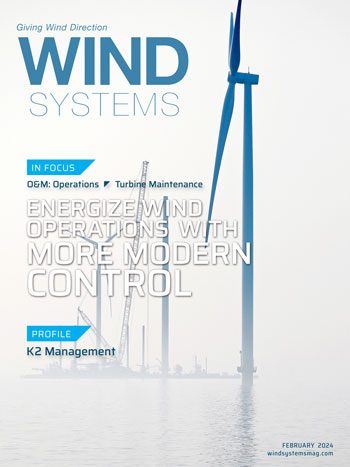We are currently updating our archive. Please check back shortly.
October 2024
Renewable energy recycling A key to sustainable power generation
As wind turbines, solar panels, and lithium-ion batteries become more widespread, the need for effective end-of-life management solutions becomes increasingly important.
Protecting the lifespan of turbine blades
With the use of polymeric leading edge protection, the lifespan of wind-turbine blades at a wind farm was extended more quickly and efficiently.
End-of-Life consideration for offshore turbines
Digital twin technology has the potential to increase the lifespan of floating offshore wind turbines through re-powering methods.
September 2024
Planning a stronger renewable sector in Canada
Despite a few challenges, Canada is still determined to meet its net-zero carbon goals, but to do so will require a strong electricity game plan to drive economic growth, create jobs, and position the country as a leader in the global-energy transition and a good place to do business.
Building the SOV fleet to support the clean-energy opportunity of a new age
As the industry begins to expand and country decarbonization targets are met, construction and maintenance of U.S. offshore wind projects will need a combination of expertise requiring a variety of specialist support vessels.
The Rising Tide of Offshore Wind: Strengthening American communities and economies
As more projects begin operation and the supply chain expands, the economic and environmental benefits of offshore wind will reach even more communities across the nation.
August 2024
Wind-turbine lubrication
Low temperature fretting wear behavior of four commercial greases
New hybrid foundation solutions for offshore wind turbines
Solid and more stable support structures are needed for new OWTs; however, an innovative “hybrid” foundation is a new type of support proposed to reduce the length of a standard monopile, increase its lateral stiffness, and ease construction in offshore conditions.
July 2024
Improving offshore wind safety
Researchers are developing technology that will provide early warnings in order to prevent divers from having to inspect underwater cables.
Rethinking wind power’s towers and turbines
New materials and designs can make a leading source of renewable energy both greener and cheaper.
Beating the heat Protecting wind-energy workers from climate change
By combining acclimatization protocols, wearable technology, weather-based work modifications, and heat safety training, employers can minimize the risks to workers’ health and productivity.
June 2024
Resilience in the storm: Lessons learned in navigating hurricanes and turbines
Mitigating risks for offshore wind farms, especially in the face of extreme weather events like hurricanes, is a complex task that requires a deep understanding of various factors.
Detecting blade problems before they become an issue
Condition monitoring sensors, used for years to detect imminent failures in a turbine’s gearbox and drivetrain, are being adapted to find often hard-to-see defects in an asset’s massive blades.
Active and passive systems for wind turbines
In the realm of wind energy, efficient thermal management within wind-turbine components, particularly the nacelle, is essential for optimizing performance and reliability.
May 2024
Developers need processing power
With the demand for developers rapidly growing, advanced simulation capabilities, GIS data integration, and enhanced processing power will be the keys for the successful deployment of U.S. offshore wind development.
Recovery on the horizon for U.S. wind
Despite challenges from a slow 2023, economics, demand, and policy are aligning to provide significant opportunities for wind going forward.
Planning your CLEANPOWER 2024 experience
A list of wind-related businesses exhibiting at the premier clean-energy trade show.
April 2024
Cultivating wind resources in the Gulf of Mexico
In order to capitalize on the U.S.’s clean-energy goals, local economic and workforce developers are looking to diversify Louisiana’s energy landscape through offshore wind production.
Women in the energy industry
Women make up only 25 percent of the workforce in the energy sector and 32 percent in the renewable energy sector; however, despite the gender gap, women have historically contributed to advancing technology in the energy field.
March 2024
Test and Repair 250 feet in the Air
The importance of inspection, maintenance, and performance enhancements on wind turbines.
3D printing vs. CNC machining for component manufacturing
While 3D printing has the potential to be an ideal solution in increasing turbine part production, it is crucial not to overlook the benefits of CNC machining.
February 2024
Water droplet erosion testing of turbine blade materials
Controlled testing throughout the turbine-blade development process is critical to selecting materials and manufacturing processes to limit leading-edge and water-droplet erosion damage and to predict their success in the field.
A holistic approach to asset risk management: Is it all or nothing?
In today’s environment, companies need to be able to also make high confidence asset integrity decisions, enabling them to increase the profitability and productivity of the asset base while minimizing the exposure to the risk of catastrophic events.
Energize wind operations with more modern control
Turbine control retrofits and green-energy solutions platforms are transforming the way operations teams manage wind-energy generation.
January 2024
Measurements and modeling of friction torque of wind-turbine blade bearings
Multiple double-row, four-point bearings of three different sizes are tested on four different test rigs, and the friction torque at different bending moments and axial loads of the bearings are measured, resulting in significant discrepancies in the torque of identically sized bearings.
By O. Menck, K. Behnke, M. Stammler, A. Bartschat, F. Schleich, and M. Graßmann
Lidar vs. Met masts for wind-energy measurement
With the Corlacky Hill Wind Farm in northern Ireland, the RES Group reveals why Lidar is widely trusted for wind resource assessment.






























